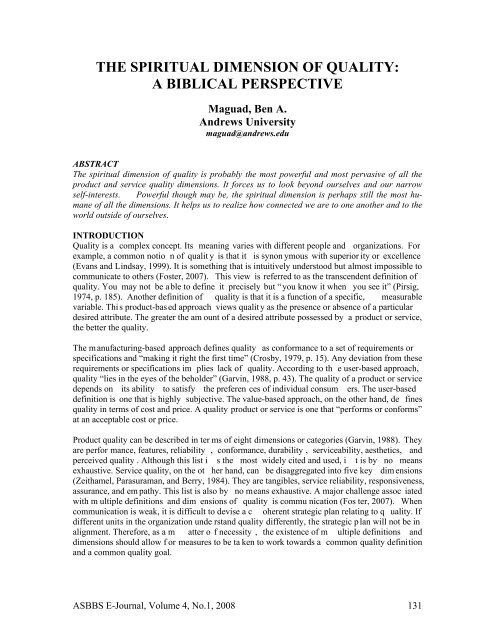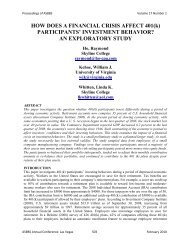stock repurchase announcements: a test of market ... - Asbbs.org
stock repurchase announcements: a test of market ... - Asbbs.org
stock repurchase announcements: a test of market ... - Asbbs.org
You also want an ePaper? Increase the reach of your titles
YUMPU automatically turns print PDFs into web optimized ePapers that Google loves.
THE SPIRITUAL DIMENSION OF QUALITY:<br />
A BIBLICAL PERSPECTIVE<br />
Maguad, Ben A.<br />
Andrews University<br />
maguad@andrews.edu<br />
ABSTRACT<br />
The spiritual dimension <strong>of</strong> quality is probably the most powerful and most pervasive <strong>of</strong> all the<br />
product and service quality dimensions. It forces us to look beyond ourselves and our narrow<br />
self-interests. Powerful though may be, the spiritual dimension is perhaps still the most humane<br />
<strong>of</strong> all the dimensions. It helps us to realize how connected we are to one another and to the<br />
world outside <strong>of</strong> ourselves.<br />
INTRODUCTION<br />
Quality is a complex concept. Its meaning varies with different people and <strong>org</strong>anizations. For<br />
example, a common notio n <strong>of</strong> qualit y is that it is synon ymous with superior ity or excellence<br />
(Evans and Lindsay, 1999). It is something that is intuitively understood but almost impossible to<br />
communicate to others (Foster, 2007). This view is referred to as the transcendent definition <strong>of</strong><br />
quality. You may not be able to define it precisely but “you know it when you see it” (Pirsig,<br />
1974, p. 185). Another definition <strong>of</strong> quality is that it is a function <strong>of</strong> a specific, measurable<br />
variable. Thi s product-bas ed approach views qualit y as the presence or absence <strong>of</strong> a particular<br />
desired attribute. The greater the am ount <strong>of</strong> a desired attribute possessed by a product or service,<br />
the better the quality.<br />
The m anufacturing-based approach defines quality as conformance to a set <strong>of</strong> requirements or<br />
specifications and “making it right the first time” (Crosby, 1979, p. 15). Any deviation from these<br />
requirements or specifications im plies lack <strong>of</strong> quality. According to th e user-based approach,<br />
quality “lies in the eyes <strong>of</strong> the beholder” (Garvin, 1988, p. 43). The quality <strong>of</strong> a product or service<br />
depends on its ability to satisfy the preferen ces <strong>of</strong> individual consum ers. The user-based<br />
definition is one that is highly subjective. The value-based approach, on the other hand, de fines<br />
quality in terms <strong>of</strong> cost and price. A quality product or service is one that “performs or conforms”<br />
at an acceptable cost or price.<br />
Product quality can be described in ter ms <strong>of</strong> eight dimensions or categories (Garvin, 1988). They<br />
are perfor mance, features, reliability , conformance, durability , serviceability, aesthetics, and<br />
perceived quality . Although this list i s the most widely cited and used, i t is by no means<br />
exhaustive. Service quality, on the ot her hand, can be disaggregated into five key dim ensions<br />
(Zeithamel, Parasuraman, and Berry, 1984). They are tangibles, service reliability, responsiveness,<br />
assurance, and em pathy. This list is also by no means exhaustive. A major challenge assoc iated<br />
with m ultiple definitions and dim ensions <strong>of</strong> quality is commu nication (Fos ter, 2007). When<br />
communication is weak, it is difficult to devise a c oherent strategic plan relating to q uality. If<br />
different units in the <strong>org</strong>anization unde rstand quality differently, the strategic p lan will not be in<br />
alignment. Therefore, as a m atter o f necessity , the existence <strong>of</strong> m ultiple definitions and<br />
dimensions should allow f or measures to be ta ken to work towards a common quality definition<br />
and a common quality goal.<br />
ASBBS E-Journal, Volume 4, No.1, 2008 131

















